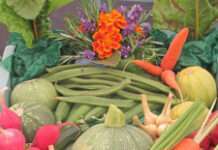K-State specialists discuss foods and activities to keep bones strong
MANHATTAN, Kan. – We know “the toe bone’s connected to the foot bone,” and so on, but how do we keep those bones strong throughout life? Fortunately, some foods and activities help with that.
“When we think of nutrients supporting bone health, our first thought is calcium – and rightly so,” said K-State Research and Extension state nutrition specialist Sandy Procter. “Calcium is a key component to healthy bones, but it isn’t the only one. Because a number of vitamins and minerals team up for strong bones, it makes sense to consider the top foods that tout a variety of bone-strengthening nutrients.”
Procter, who is a registered dietician, listed these foods that support bone health:
• Dairy products, including milk, cheese and yogurt. These foods also supply phosphorus, another important nutrient needed for bone health.
• Seafood. Canned seafood products, including salmon, sardines and shrimp are good options, as they have an even higher calcium content than fresh or frozen.
• Leafy greens, especially spinach, bok choy, collard and turnip greens.
• Legumes, seeds, almonds and tofu.
“Other foods and beverages are fortified with calcium and play an important role in our total intake. Breakfast cereals, juices and nut- or seed-based milks often have calcium added during processing, as well as vitamin D. That’s important,” Procter said, “because you cannot absorb the calcium you eat without enough vitamin D.”
Your body makes vitamin D when the sun shines directly on your skin and it only takes 10-15 minutes of sunlight a couple of times a week to get what you need, said Sharolyn Jackson, K-State Research and Extension family and consumer sciences specialist. As we age, our skin gets thinner and less efficient at synthesizing vitamin D from sunlight.
“Research continues to evolve on how much vitamin D we need and for many of us, a supplement is a good idea,” said Jackson, who coordinates the statewide Walk Kansas program.
Other minerals, like magnesium and potassium, help keep bones healthy. Magnesium helps with your body’s vitamin D balance and potassium aids in reducing calcium loss from bones. Good sources include spinach and other dark greens, potatoes, sweet potatoes, bananas, legumes, nuts, seeds and whole grains.
Protein is another key nutrient for bone health at all stages of life. Most people, but not everyone, get enough. Older adults don’t always eat enough protein. If you are considering eating more protein, consider plant sources too, like nuts and beans. They offer calcium as well as protein.
What’s at stake?
“Bone is living tissue, just like muscle, and key bone-building years for your body is when your skeleton is growing – typically through your mid-20s,” she said. “What is built in those years must last a lifetime. After age 35, we gradually lose bone as a part of the natural aging process.”
Bone in our bodies is constantly being broken down and replaced. Osteoporosis is a bone disease that happens when the creation of new bone is unable to keep up with the loss of old bone. The word “osteoporosis” is from the Greek terms for “porous bones.”
“It’s a silent disease. You can’t feel your bones weakening,” Jackson said. “The first signs may be stooped or humped posture, you get shorter, or a bone breaks. With osteoporosis, bones can become so brittle that a fall or even something small like coughing or bending can cause a fracture.”
Women, older adults (risk increases with age), and people who are white or of Asian descent are among those at the greatest risk. So are those with a family history of osteoporosis and having a small body frame. Hormone levels, diet, long-term use of some medications and medical conditions can also play a role.
“It’s important to be aware of personal risk factors, but it’s also important to do what you can to reduce your risk,” Jackson said. “Healthy eating and regular exercise are essential for keeping your bones healthy and maintaining your quality of life.”
Weight-bearing exercise is best for prevention, including brisk walking, hiking, jogging, marching, climbing stairs, weight training, dancing, yoga, and tennis. Even gardening can be weight bearing if you carry a water can or tools or walk in the yard. Jumping, stomping and hopping also work as they jar your bones a little, sending a message that they need to get stronger.
“So, have a little fun and act like a child again,” Jackson said.
More information about human nutrition is available on the K-State Extension Food, Nutrition, Dietetics and Health
FOR PRINT PUBLICATIONS: Links used in this article
K-State Extension Food, Nutrition, Dietetics and Health https://www.ksre.k-state.edu/humannutrition/
K State Research and Extension is a short name for the Kansas State University Agricultural Experiment Station and Cooperative Extension Service, a program designed to generate and distribute useful knowledge for the well being of Kansans. Supported by county, state, federal and private funds, the program has county extension offices, experiment fields, area extension offices and regional research centers statewide. Its headquarters is on the K State campus in Manhattan. For more information, visit www.ksre.ksu.edu. K-State Research and Extension is an equal opportunity provider and employer.
For more information:
Sandy Procter
[email protected]
Sharolyn Jackson
[email protected]
Written by:
Mary Lou Peter
[email protected]





